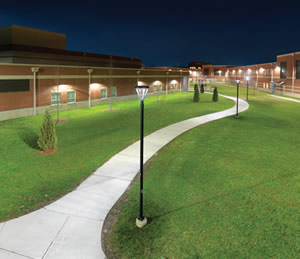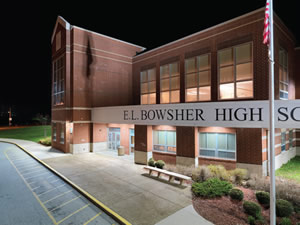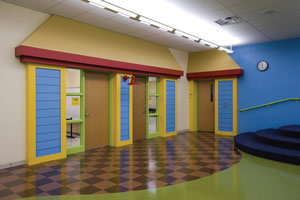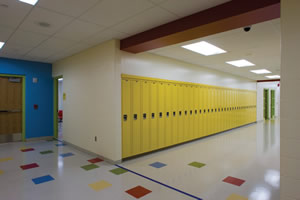Security Assessments: Doors, Locks, Lighting, Oh My!

PHOTO COURTESY OF CREE, INC
“In 2013, Wyoming legislators asked us to conduct a thorough physical security assessment to ensure that we maintain a world-class condition relative to school security,” begins William T. Panos, director of Cheyenne-based Wyoming School Facilities Department (WSFD), which is dedicated to finance, design and construction. “We have 48 school districts, 1,300 facilities and 25 million square feet, so it was no small undertaking.
“The legislature provided the dollars to create an updated standard for assessing our facilities, which we did in the fall of 2013, and then developed a program to quickly assess all 25 million square feet,” Panos continues. “It was similar to doing an audit. We created a geographic grid and developed 10 teams. We named a security contact at each school district, who organized individuals at each school to work with the teams to assess each school using the standard. Before launching the program, we did a pilot at our largest school district to work out the bugs. Finally, we completed the assessment in 90 days — every door, lock, window and more for a total of 73 components.”
The assessment showed no real surprises, primarily because that wasn’t the point. As Panos notes, “We were accumulating data to communicate with others in an understandable way and create a strategy to move forward.” To communicate clearly, the assessment findings were prioritized from highest to lowest and shared with the legislature.
“We estimate it will take $180 million to correct all the items we’ve identified,” says Panos. “We’re already made great progress on the high-priority items with $9 million provided by the state. This includes fundamental security items, including key systems, door locks and the ability to electronically control the locking/unlocking of doors. These elements are already present but are inconsistent.”
WSFD is expecting another large amount of money for the 2017-2018 biennium to continue moving forward in implementing assessment results. This next stage will include cameras, remote sensing, remote audio/video control by law enforcement, security vestibules and badging systems.
Panos indicates that there’s not an established timeline for implementing all of the assessment results. “While the message from our legislature is to complete it as fast as we can, it will depend upon the budget and the capacity to get it done,” he explains. “Because we’re in Wyoming, sometimes there’s an issue with having all the capacity required to complete work. Still, the pedal is all the way to the floor.”

PHOTO COURTESY OF CREE, INC.
Interestingly, while WSFD was working on the physical assessment, a separate but related effort was in motion. “The legislature asked us to partner with Wyoming Department of Education and the Department of Homeland Security regarding non-physical security components,” says Panos. “They’re working on procedures and protocols, coordinating with law enforcement agencies, training staff and parents, and communication.”
Performing a security assessment
If Wyoming’s physical security assessment makes you think, “Hmm, maybe we should do something similar” — you’re right. “As planners, we need to understand that a safe environment is not just a concern of administrators, but also of students,” says Michael E. Hall, AIA, REFP, LEED-AP, president, educational facility planner and architect with Fanning Howey, which has offices across the United States. “We’re designing an elementary school at West Point Military Academy in New York. During a design charette with 4th, 5th and 6th graders at the academy, we asked them what they wanted in their building. Their biggest concern was feeling safe.”
If you’re ready to move forward, here are some guidelines to help you get started. Know that these guidelines are designed for a physical security assessment. As in the case of the State of Wyoming, a parallel program would address such management issues as procedures and protocols, coordinating with law enforcement agencies, training staff and parents, and communication.
Hire experts: “The best thing school officials can do is hire design professionals who are familiar with the dynamics and practice of education because there’s a balance in creating a safe and welcoming environment vs. creating a secure environment that looks like a juvenile detention center,” says Dr. Ronald Stephens, executive director, National School Safety Center, Westlake Village, Calif., which serves as an advocate for safe, secure and peaceful schools worldwide and as a catalyst for the prevention of school crime and violence. “You want also to include a security professional who’s trained and well versed in school safety strategies and operations and has conducted school safety site assessments.” When the walkthrough is performed, the team should include both of these experts and the principal, who knows the locations of problem areas.

PHOTO COURTESY OF LWC, INC.
Checklists: Where can you find a list of criteria to assess? “The DoD (www.defense.gov) manual has checklist upon checklist of safety and security design criteria,” indicates Hall. “And there are CPTED documents. We use both to identify a school’s security weak points.” Of course, the professional you hire should be well prepared with a checklist.
CPTED: CPTED (Crime Prevention Through Environmental Design) is a multi-disciplinary approach to deterring criminal behavior through environmental design. Learn more about it through the International CPTED Association (ICA) (www.cpted.net/), as much of the assessment will relate to this common-sense approach to security.
Work from the outside in: When we do a security assessment,” says Ed Soots, AIA, LEED-AP, senior associate with LWC Inc., which has offices in Dayton, Ohio, and Richmond, Ind., “we begin with the perimeter and work our way in. We see what is there, what isn’t there, what is deficient. Then we give options on how to make improvements.”
Stephens agrees, noting that the layers begin off campus with Drug-Free School Zone laws, which vary by state. The next layer is the perimeter: Does it need to be fenced? How successful is access control for pedestrian and vehicular traffic? The next layer is entrances/exits: Do you have a secure vestibule for guests to enter? Are doors secured and easily visible? And the final layer is the interior. Are hallways well lit? Do interior doors lock from the inside?

PHOTO COURTESY OF LWC, INC.
Specific assessment elements
There are specific elements that the experts recommend you consider for improved safety and security, and which will be found on an assessment. Here are a few. Exterior lighting: “A key to creating a safe and visible exterior is an equal level of lighting broadcast around the area to be lit,” says John Casadonte, vertical marketing manager for Durham, N.C.-based CREE Inc., a multinational manufacturer of semiconductor light-emitting diode materials and devices. “For example, we worked with a school that experienced problems in its parking lot after dark. What we discovered was that the existing lighting was high footcandle but poor distribution, which created bright spots and dark spots. After installing LED lights, the parking lot was evenly and well lit and, as a result, the school has seen a reduction in security incidents.”
Another lighting element that will come up in an assessment is whether to have light after dark. San Diego City Schools in Calif. has a lights-off policy, notes Stephens, which was a community decision and which has saved a lot of money through the years.
Doors: Both exterior and interior doors must be vandal-proof. “In the old days you could run a coat hanger through double doors, pull the grab bar and open the doors,” says Stephens. “Today’s doors are more difficult to defeat. You want door hardware that can be effectively secured and meet fire code exit requirements.”
There’s also the question of whether doors should have windows. If you opt for windows for transparency, know that they’re well made. “At Crawfordsville Middle School in Indiana,” says Soots, “we installed a main entrance door with half-inch-thick laminated glass. The glass is made of a heavy plastic inner core sandwiched with two layers of glass so that, if the glass breaks, the core holds everything in place. It’s not bulletproof, but it is heavy. It’s designed to buy time for the police to arrive and stop the intruder. It’s an option for interior doors and sidelights, as well.”
Entrance vestibules and proximity cards: Vestibules and proximity cards are now common secure entrance practices. With vestibules, visitors can’t pass through into the school until they’re identified and a staff person electronically opens the door. Proximity cards issued to staff and visitors track who’s coming and going. As a bonus, they’re programmable so that, if one is lost or a staff member is fired, it can be decommissioned
Transparency and Lockdown: Schools need internal transparency so teachers can see what’s going on around them. They also need adequate security access points that are controlled within the building and the ability to go into lockdown in small neighborhoods. “A few years ago we designed Greene County Tech High School in Paragould, Ark.,” says Hall. “Because of memories of the shooting that occurred in nearby Jonesboro in 1998, the principal and teaching staff desired a school where they could stand in the middle of an academic section and see down every hallway to know what’s going on and who’s there.”
Soots, who did a similar zone design for a Dayton, Ohio, public school, also addresses intruder locks: “If someone gets past the secure entry vestibule, the secure zones provide a second layer of protection: The interior doors have an intruder lock function whereby teachers can lock doors from the inside.”
Video surveillance cameras: Surveillance cameras are common in today’s school environments. “They can have a positive effect on deterring crime,” Stephens points out. “In many cases, a good surveillance system will more than pay for itself through savings in vandalism repair costs. Do post that the cameras are there to put potential intruders on notice.”
The experts in this article offer two takeaways regarding physical security assessments. The first is that administrators have to understand that the climate of the country in which we’re building schools is different from what it used to be. Safety and security have taken the front page, and that must be reflected in our schools. The second is that we don’t want our schools to look like Fort Knox, but we do want them to be safe. Therefore, we must take reasonable steps within our budgets and capabilities to do what we can to create safe schools, with the understanding that any person intent on violence will find a way to defeat security measures.
This article originally appeared in the issue of .